#seagull watch
Explore tagged Tumblr posts
Text
Seagull Watch Year of the Dragon 2024 Limited of 99 Pieces
The Coiled Dragon Lies Hidden, Lacquer Glitters Like Golden
To usher in the Year of the Dragon in 2024, Seagull Watches have developed a lacquer tourbillon wristwatch incorporating the Chinese intangible cultural heritage craft of lacquerware with exquisite mechanical precision, creating a culturally rich collectors' and showpiece high-end wristwatch.
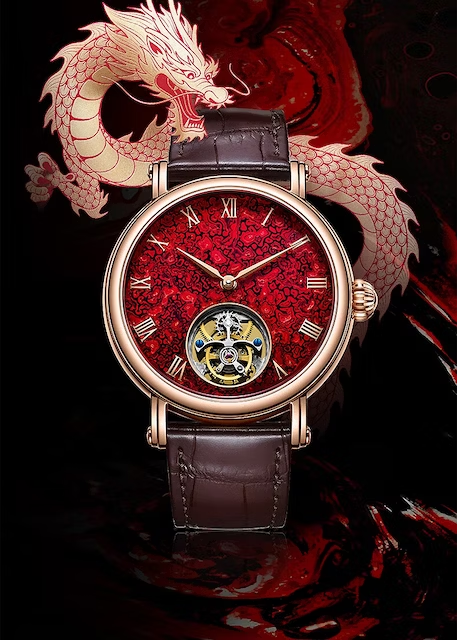

The design of this double-sided watch dial sees the tourbillon side take on a rhinoceros leather lacquer texture to signify the scales of the dragon's body, swirling with flowing clouds and water as if there is a coiled dragon lying within the dial, poised to strike. The dragon head "conceals" itself on the reverse side, alluding to the Chinese concept of "Crouching Tiger, Hidden Dragon," and is inspired in design from the dragon patterns on Tang dynasty imperial robes, robust and majestic.
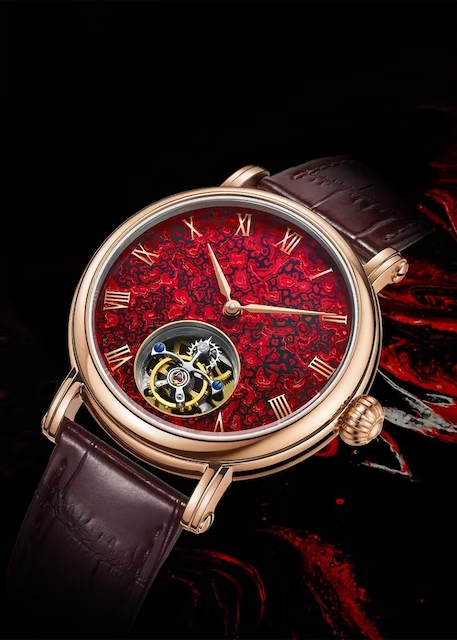

Parts of the dragon body and dragon pearl inlay use opal gemstones, one of the Five Great Jewels, combined with golden lacquer, employing lacquer with gold and radiant opal sparkle to signify the luster of the dragon scales and jewels; the dragon teeth inlay uses white shell dots in combination with silver lacquer inlay; and the dragon head and tourbillon side respectively apply rhinoceros leather, lacquer inlay, gilding, dome accentuating techniques with polishing and reflections paired with silk-pinching to form rich solid-void contrast with the lacquer textures, amplifying a heightened sense of depth through the watch dial, while the dragon tongue area uses plain vermillion lacquer containing trace cinnabar elements for evil-warding.
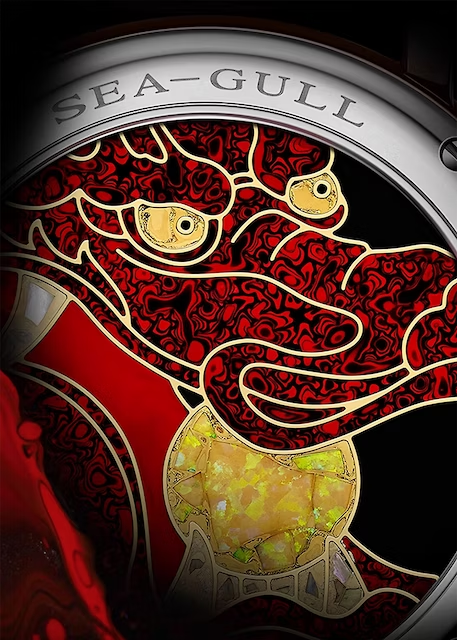
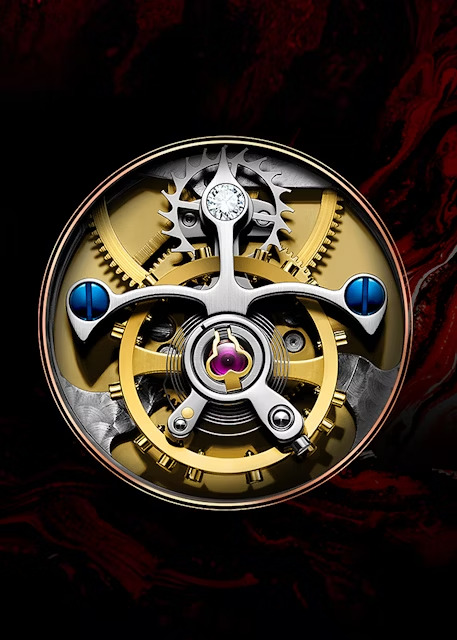
The overall watch utilizes a dual-layer design, with the outer-facing surface giving prominence to the subtle charm of pure lacquer craft, and the off-center tourbillon at 6 o'clock adding dynamic motion; the underside fuses an auspicious pattern from Chinese art of a dragon playing with a luminous pearl, symbolizing tireless pursuit of the good life and continuous spiritual legacy spanning generations; the motif signifies blessings for prosperity and happiness filling one's home.


#year of the dragon#chinese new year#dragon art#seagull watches#seagull watch#tourbillon#chinese watch#2024#watchcollector#watchcollection#lunar new year#jewelry#jewellery#watch#timepiece#luxury watches#fashion#accessories
4 notes
·
View notes
Text






It's not that difficult to stand on water (when there is a layer of ice under the surface)
#photographers on tumblr#original photography#birding#bird photography#bird watching#seagulls#möwen#Lübeck#reflection
149 notes
·
View notes
Text
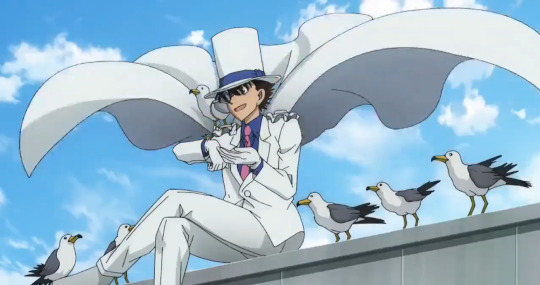
please, tell me i'm not the only one who is obsessed over kaito chilling there and making friends with seagulls
#detective conan#kaitou kid#anime#the magical agent of chaos#detco posting#la junk talks#magic kaito#honestly one of the best things that came out of movies: kaito interacting with ANIMALS#first the goat. now THIS.#GIVE ME MORE#HE JUST LIKES ANIMALS. LIL CREATURES TO MAKE FRIENDS WITH#HE JUST LOOKS SO CAREFREE#HE JUST WANTS TO EMBRACE THE JOYOUS WHIMSY#after seeing the lil promo video i thought they were doves#then i watched it again and went: WAIT A FCKIN MOMENT SOMETHING IS NOT RIGHT#and indeed THEY ARE SEAGULLS#i fckin love him
310 notes
·
View notes
Text
The State Birds Initiative: New Jersey (#3)
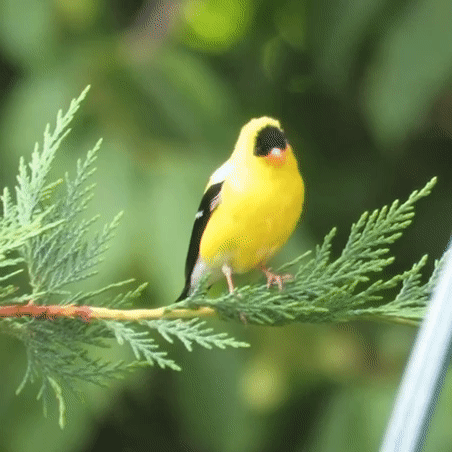
Welcome to the third official poll of the State Birds Initiative! Before the poll, though, one thing real quick. My suggestion is that you read the post below before voting in the poll below. That's especially important if you're lacking any context about the birds being presented as the new (or old) State Bird of the Garden State, New Jersey. This is to be fully informed as to why these are being presented, and to make your choices appropriately. Lastly, some of these birds, you will notice, may go against some of the rules listed in the introduction post. All is explained after the jump where the explanations are, I promise you that. But with that...OK! Here's the poll! If you'd like to see the last post, check out Pennsylvania (Poll | Results)
So, with that done...New Jersey.

OK, I'll be honest, I have very little history with New Jersey. Only been there a few times, I've driven through it a decent number of times, and I mostly know it by reputation. But, uh...for whatever reason, every trip I take that requires me to go through New Jersey, NJ is the worst driving portion of that trip. Basically every time. Maybe that's a New Jersey turnpike problem, maybe that's unhappy coincidence. Hell, maybe it's conservation bias from being a New Yorker (upstate, but I've gone to the city regularly throughout my life). Or maybe it really is cultural reputation for New Jersey trickling in to my subconscious (looking at you, Jersey Shore). But either way...I have complicated feelings about New Jersey.
But this post is NOT about my personal geographic experience. Mostly. It's about birds! So, let's get into New Jersey objectively. Third state admitted into the union, state capital is Trenton, largest city is Newark, and it's the most densely populated state in the country. Famous for being the origin of electricity in civic infrastructure, as well as the home of their favorite son, Thomas Alva Edison. Which...when you learn more about the guy, makes you wonder about New Jersey as a whole. MOVING ON! It was a major staging point in the American Revolutionary War, and ever since, it's been all about freedom. Even though you can't pump your own gas there. Although, to their credit, the Statue of Liberty is actually technically in New Jersey waters. Yeah. That's absolutely true. But, like...it's spiritually a New York landmark, so we'll let it slide.

Now, here's the thing about New Jersey, seriously and truly. It has a bad reputation because of media and New York City. This is for two more specific reasons, from what I can tell. One, the New Jersey Turnpike sucks, and it smells like raw sewage due to its proximity to industrial factories and processing plants. And unfortunate way to experience the state, and the main way I've experienced New Jersey personally. So, that's one, and it's not indicative of the state's quality. Number two is simply the fact that it's a hub for commuters, with lots of people going to either NYC or Philadelphia for work. Because of that, Jersey itself gets pieces of their cultures combined, which also makes it a very easy target with a unique accent. So, not Jersey's fault.
In reality, it's quite a nice state with more natural area than you'd expect for somewhere so densely populated. New Jerseyans, unsurprisingly love their state...and aren't big fans of tourists, from discourse I see online. It's a small state, which makes it crowded enough. Plus, there are tourist attractions there. There's the massive American Dream Meadowlands mall, there's MetLife Stadium, there's Six Flags Great Adventure, there's...Trenton. Actually, no, Trenton sucks, I stand by that assessment. But it's also a highly diverse state, with the highest proportion of Hinduism followers in the country, as well as the densest collection of LGBTQ+ social centers (AKA gayborhoods), amongst other things. NJ does deserve more credit.
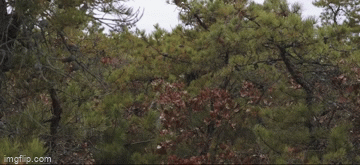
Now with that said, let's talk about the natural world of New Jersey, because there is a surprising amount to talk about. 45% of the land is covered in mixed deciduous-coniferous forest, which you've probably noticed is typical of the NE USA. Oak is our primary tree here, which is also probably why Northern Red Oak (Quercus rubra) is the state tree. It also has some major ecological features that are well known for its natural advantages. Cape May is a seaside city and vacation resort, but also one of the most well-known and important sites for birders from the United States during migration seasons, making it immediately prominent for this post. Great Swamp NWR in the north is the first wilderness area ever designated by Congress, and also serves as a major refuge for birds during the breeding season for various reasons. And maybe most importantly, the New Jersey Pine Barrens are the largest remaining pine barrens in the NE USA, and act as a bastion of diversity. More on this later, I promise; there's a species entry dedicated to this unique environment.
And that's not all to talk about here. NJ's environment needs some focus for a number of reasons, not least of which being that the state has more toxic waste dump sites than any other state in the Union, which are the focus of the federal Superfund environmental remediation program. Yeah, there's some cleanup that needs to happen in the state, especially as it is so small. Of 150 federally listed sites, only 35 have been cleaned up since the 1970s. So, yeah. We should get on that, please. But with that said, NJ has relatively low carbon dioxide emissions compared to other states, they're seventh in solar power, and get most of their electricity from natural gas and nuclear power. So, it's a greenish state that could be a lot greener.
There's a lot to talk about for such a small state, it would seem. Let's not linger about, and let's get on with the show here! I'm honestly kind of excited. Birds after the jump!!!
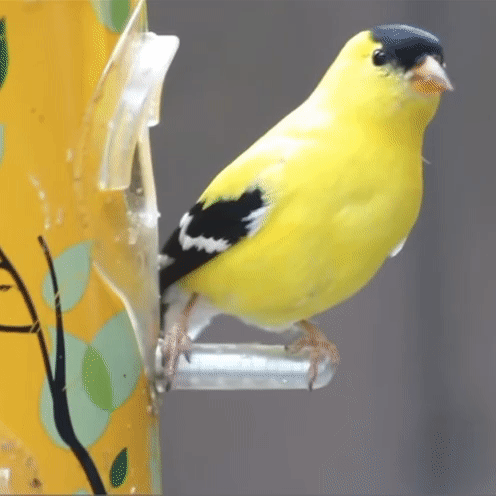
American Goldfinch (Spinus tristis)
Let's kick things off by talking about the incumbent, the American Goldfinch (Spinus tristis). Now, why was the American Goldfinch chosen as the State Bird of New Jersey in 1935? Easy answer: favoritism. The bird was nominated as the only candidate by the New Jersey Audubon Society because...it was their mascot at the time. Yeah. That's it. In reality, the New Jersey State Bird is the New Jersey Audubon Society. And even then, it's officially lost its relevancy, because that's not their mascot anymore. More on that later.
What's actually worse about the goldfinch here is...for some reason, not a lot of New Jerseyans have actually seen them. Part of the reason for this entire series, by the way is this Reddit post, which stoked the fires that had long been simmering deep within my soul. OK, not that deep, but still. Anyway, the header of that post is that the OP had barely ever seen an American Goldfinch, despite being a native. I thought that was insane (and said as much in my comments), because this is a ridiculously common bird, especially for birdwatchers. But, uh...I've looked into since then. And only 0.4% of its global breeding population resides in the state. What's crazy is, this is a common sentiment amongst New Jerseyans. They just...haven't seen this bird. And obviously, that/s not every new Jerseyan, and a lot have reported seeing it. But to be honest...is this bird really worth being called the State Bird of New Jersey?
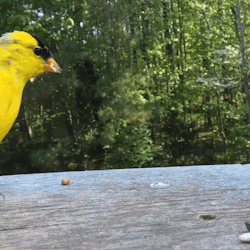
OK, can we make the American Goldfinch make sense in retrospect? Let's see, they're a highly social finch species throughout the year, living in dense colonies in the spring and summer especially. The males are late breeders with ornate flying displays meant to attract females, and may group territories with other males to defend against predators. And they're an open secondary growth forest specialist that live in the state year-round, including during the breeding season. Which means...well, actually, it means that they're perfectly suited to live in New Jersey, funnily enough.
Hear me out here. There are two things that goldfinches love most: forest clearings and weeds. New Jersey may be 45% covered in forest, but it does have deforestation as a minor problem around its settlements. However, that's not a problem for the goldfinch, who thrives in secondary growth forests that occur as a result of succession. Given an attempt in recent decades to recover New Jersey's forests, this means the goldfinch is a potential symbol of these efforts. Plus, its love of the seeds that come from flowers that are pest plants, like dandelion, thistle, ragweed, and cosmos, make it a potentially attractive bird for gardeners of the state to attract, especially as those plants thrive in open fields during stages of succession!
...YES I'M STRETCHING MORE THAN AN AUSTRALIAN BREAKDANCER WITH A DOCTORATE TRYING TO MAKE A POINT, BUT WHAT ELSE AM I SUPPOSED TO DO WITH THIS MASCOT OF AN ORGANIZATION NAMED AFTER A SLAVE-OWNER???
So...moving on.
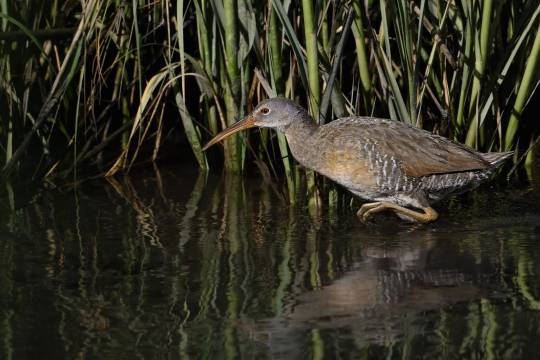
Clapper Rail (Rallus crepitans)
While the majority of natural New Jersey is covered in forest, it still has a fairly important habitat in the form of the saltmarsh. Just to get the definition in place early, a saltmarsh is essentially what it sounds like: a vegetation-dominated coastal biome with salt and brackish water, salt-tolerant grasses and plants, and the animals that depend on such. They're coastline preservers, trapping and binding sediment as it makes its way to and from the ocean, and acting as a major supply for the food web along the coasts. They're incredibly important habitats, and this will not be (and have not been) the last time you've seen them during the State Birds Initiative.
Now, obviously, these habitats are chockful of birds. New Jersey has a few major salt flats along its coast, all of which shelter some major breeding populations of birds. One of these species is the Clapper Rail (Rallus crepitans), which is our eBird-sponsored pick of this poll. Clapper Rails have 13% of their global population in New Jersey saltmarshes, meaning they're quite dependent on this unique habitat, and most of their population breeds in the state. Some people may never have seen or heard of a rail, but in case you're one of those people, just know that they're a smaller semi-aquatic relative of cranes. If you've seen a coot, moorhen, or gallinule, then you've seen a rail! And the Clapper Rail is a crustacean-eating, saltmarsh-loving, new Jersey-dependent example. And that said...it is kinda boring looking to the average person.
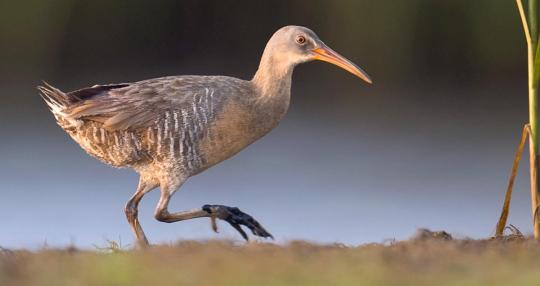
Don't take me wrong! For me, this bird is fantastic, and would actually be a lifer for me, personally. But the average non-birder? Look, in instances like this, I usually tap into the part of my brain my fiancee lives in rent-free, and all I can hear is her shouting "LONG DUCK LONG DUCK" over and over. I love these guys, but I'm not sure they'd resonate with the public. Plus, as far as saltmarshes go, these are good representatives, but I'm not sure they're the best. Are these a good New Jersey representative? Possibly, since they represent a major ecosystem in the state, and that is important. But I'll leave that question to you all. Moving on!
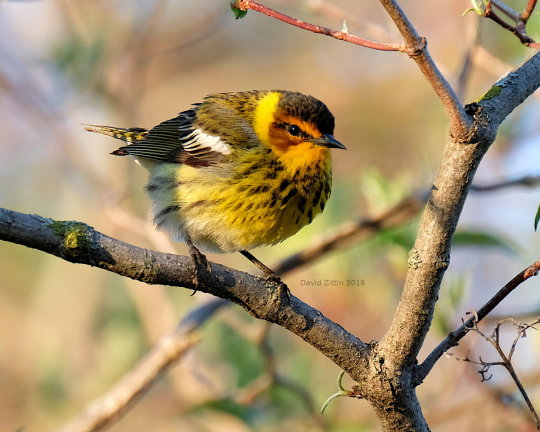
Cape May Warbler (Setophaga tigrina)
OK, onto the category of birds that are named after the state, and New Jersey has one of those! The Cape May Warbler (Setophaga tigrina) is so-named because the first specimen described by Alexander Wilson was collected in Cape May, New Jersey by George Ord. That said, it's certainly a unique warbler, easily recognizable, and dependent upon conifer forests dominated by spruce, which the Pine Barrens are...not. Still, an iconic bird in New Jersey! Except...wait, hold on...ah. It doesn't breed in the state. In fact, after it was described from a Cape May specimen, it wasn't seen in the area again for...a century. So...yeah, it's named after a major location in the state, known for birds at that, and yet it's barely found there?Love this bird, but...maybe think about renaming it one of these days.

Pine Warbler (Setophaga pinus)
Now, the Pine Warbler (Setophaga pinus), on the other hand, that's a better warbler representative of New Jersey. Well, sort of. To be fair, the Pine Warbler only has 1% of its global breeding population in New Jersey, so the state isn't a bastion or reservoir for the species. However, there is a major reservoir of the species in the New Jersey Pine Barrens, which I'd mentioned earlier. And hey, Pine Barrens, Pine Warbler...slam dunk for representation of the habitat right there. And yeah, that's absolutely relevant to the species as a whole. They live, eat, and breed in pine-dominated forests, exactly like (and including) the Pine Barrens. It's actually listed as a "Significant Congregation" species by the New Jersey Audubon Society.
And as for making a good State Bird of New Jersey? It's a notable bird, even keeping the goldfinch's yellow with white wing bars. It's not terribly difficult to find, especially during the breeding season in areas like the Pine Barrens. And hey, they're even well-known to live with other species, making them an important biodiversity indicator for conservation purposes. Plus, if people go out to look for the Pine Warbler in the wild, they'll likely encounter other species like the Blackburnian Warbler (Setophaga fusca) or the Tennessee Warbler (Leiothlypis peregrina), amongst others. Fostering interest in birdwatching by chance! It works in a conservation sense...but I don't know that it's particularly emblematic of New Jersey, to be fair.
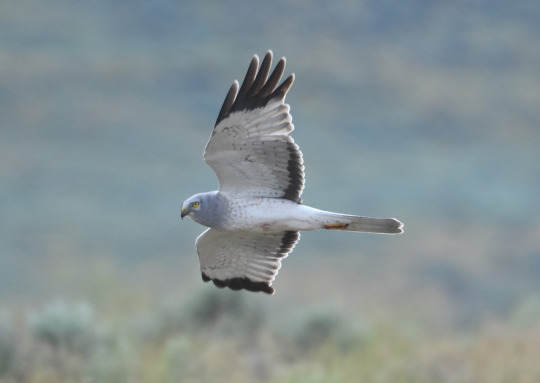
Northern Harrier (Circus hudsonicus)
Now, here's an interesting choice! If the current State Bird, the American Goldfinch, was chosen because it was the mascot for the New Jersey Audubon Society at the time, then by that logic, their current mascot should actually be the State Bird of New Jersey. And so, in that case, may I present to you the current mascot of the NJ Audubon Scoiety, and the next candidate for State Bird...the...is that a Northern Harrier (Circus hudsonicus)? Yeah, looks like it, and some sources I have confirm that's the case. But, uh...why?
Let me be really clear about something first off: I adore the Northern Harrier. Also caleld the marsh hawk, they're a beautiful raptor native to brackish and salt mashes, as well as grasslands and fields, hunting small mammals, insects, and the occasional bird. They're one of the few accipiters that are silent fliers, ambushing prey from above like owls. They even have the disc-like face. They're one of the new North American raptors with sexual dimorphism (the smoky gray male is pictured above, as compared to the brown females), and their iconic coloration has given them the nickname of the Gray Ghost. WHICH IS BADASS. They're also one of the only polygynous raptors, meaning a male can mate with several females in a given season, nesting on the ground and hatching chicks. Because of their unique relationships, some indigenous peoples see them as a symbol of healthy marriage. Finally, these are considered good for agriculture, as they eat rodents and not chicken. I love harriers, they're super neat birds, and it's always a pleasure to see them in the wild. Also, they DROWN THEIR PREY!!! What the hell! That's terrifying!
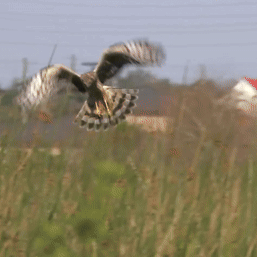
OK, harriers are cool, but do they have a relevance to New Jersey outside of being the logo of New jersey Audubon? Well...they do breed there...barely. But they've been observed doing so, so that counts. They represent key habitats in the state of New Jersey, so that's great. Their certainly charismatic enough (GRAY GHOST), and they've got nationwide conservation concern as an endangered species. So, it has those qualities going for it as the State Bird candidate. We'll see what the poll says. In the meantime, let's move on!
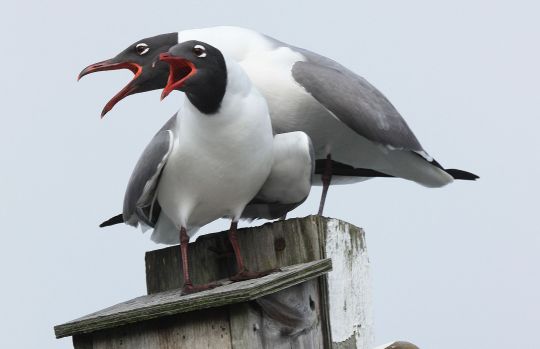
Laughing Gull (Leucophaeus atricilla)
Y'know, my original plan was to put the Ring-billed Gull (Larus delawarensis) in this list as well...and then, I stumbled upon a fun fact. The black-headed cousin of the Ring-billed Gull, and Laughing Gull, is a regular traveler to New Jersey, and in fact has a colony right off of the Jersey Shore, making them a fairly well-known and recognizable resident of an iconic area of the state. But pretty importantly, the species has a pretty massive breeding population in New Jersey. 5% of the breeding population of the species are in southern NJ, which isn’t the bulwark of their breeding population in the USA (that'd be Louisiana, according the eBird Status and Trends), but it's still a significant portion.
That said, the Laughing Gull is a recognizable member of the New Jersey shore community, and I mean the term "community" in multiple contexts. Ecologically, they're omnivorous scavengers that are well-adapted to living in a densely populated state, as well as in saltmarshes and other coastal environments throughout New Jersey. Sociologically, they hang around human settlements so much that they see opportunities in human hands...literally. The Laughing Gulls of the Jersey Shore are pretty notorious for stealing food out of the hands of beachgoers and boardwalk visitors. There are even boardwalk restaurants with signs saying they won't offer refunds if your food is stolen by a gull. They're SO notorious, in fact, that falconers have been hired to use their falcons to drive away these birds. And honestly...that's a shame. After all, the Laughing Gulls are such prominent citizens that humans have had to adjust to them.

But that said...I'm gonna quote Brian Donahue, the reporter at the end of the video/new report I linked to above...because it's hilarious, and it makes an interesting statement that I think people from New Jersey should think about. Read the quote, but trust that I have a somewhat well-thought out idea supporting it.
Derided as "flying rats" by many, I think it's time to reconsider the Laughing Gull, because if things haters say about Laughing Gulls (they're loud, feisty, there's too many of them... (Interviewee Kathy McCarey): They're rude...they're very demanding...and they come for what they want...I don't like 'em.) ...are the same things haters often say about New Jerseyans. Laughing Gulls are us. They deserve more respect.
youtube
Look, as extremely funny as that point is...there's a point about that statement. That is something that people say about New Jerseyans! They live in a state full of garbage, they're obnoxious and loud, all of that kinds thing. And New Jerseyans love their state as much as anybody else; SO MUCH, in fact, that many people online say they actually love that stereotype, because it means that people STAY OUT OF THEIR STATE. Funny or not, true or not...there's a point there. Laughing Gulls, as with all gulls, have a bad reputation, which is mostly undeserved. They're opportunists trying to feed themselves and their young, who see a smorgasbord of food right in front of them, in their neighborhood! In their place, what would YOU do? Honestly, these guys are a solid contender for that reason alone.
Plus, honestly...it's kinda funny.
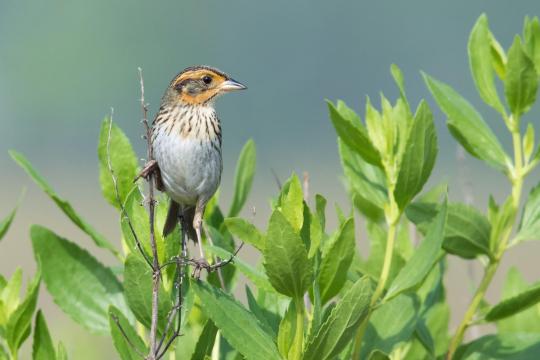
Saltmarsh Sparrow (Ammospiza caudacuta)
Finally, let's look at the conservation focus for this post: the Saltmarsh Sparrow (Ammospiza caudacuta). So, this is a pretty big one, especially when looking at New Jersey. A full 32% of the species' global population breeds in this state, which is, frankly, a MASSIVE proportion of any species. What's more, they're considered an endangered species, which immediately makes this an impressive contender for the State Bird of New Jersey. And as one of the most endangered species in the Eastern USA, not to mention a species of immense scientific interest for ecological and genomic reasons, this bird should get some attention by the public and federal government.
However...and this is a point to be made here...it's not exactly the most iconic bird for non-birders. As a birder who would kill to get this on his lifelist (I AM WORKING ON IT, LITERALLY TOMORROW AS I AM TYPING THIS), this is a prominent bird within certain communities. And to others? Ugh, this is gonna hurt me to say, you have no idea, but...it's a sparrow. It may be a little harder for people to become attached to a sparrow, and even more difficult for people to recognize the Saltmarsh Sparrow specifically.

Don't believe that this matters? Do me a favor, bird people. Show your non-bird friends Bird A, Bird B, and Bird C. Ask them how many different species you showed them. I'm willing to bet the especially observant will say 2. The less observant are gonna say 1. And throw in these top two pictures, while you're at it. I'm willing to bet you'll still get a 2 or 3. Because, unfortunately, to many people, sparrows all look pretty similar. And going forward, that's something we'll have to keep in mind: a unique appearance. What makes a bird iconic is also in its uniqueness and identifiability. And sure, maybe I'm not giving the average person enough credit, but we're also talking about children. I've said it before and I'll say it many times over: kids are important targets to consider when choosing natural State Symbols. And I really don't know how many adults could tell the difference between some sparrows, even professionals. And, uh...the Saltmarsh Sparrow is a very important example of this, because it wasn't even a species until the '90s.
Oh, and kudos to those of you who caught on immediately to my little trick up there. Probably a good amount of you noticed it, but if you didn't...there are five species of sparrows shown in this post. The two birds pictured in the post? Different species. Yeah, hearing that now makes that more obvious, but you may not have noticed it immediately. The first bird pictured is indeed the Saltmarsh Sparrow. The second bird, however, is the Nelson's Sparrow (Ammospiza nelsoni), which was once considered the same species as the Saltmarsh Sparrow. Dirty question, I know, but it's also found in New Jersey. Not a breeder there, but it's enough to cause a bit of confusion. See what I mean?
Oh, as for the rest, Bird A is LeConte's Sparrow (Ammospiza leconteii), Bird B is a Savannah Sparrow (Passerculus sandwichensis), and Bird C is a Grasshopper Sparrow (Ammodramus savannarum).

Please understand, bird-peeps: I hate making this argument. Genuinely. The New World sparrows are a wonderful group, and a really fun one to play around with and hunt down as a birder. And don't worry, sparrows will be getting a mention in my personal list. But as for the State Bird? I'll let you all decide.
And with that, that's the end of this post! I miss any big ones? Make any leaps a bit too big? Feel free to let me know! In the meantime, stay tuned for State #4 - Georgia! Wait...wait, the fourth state to be admitted into the Union was Georgia? Huh. Go figure.
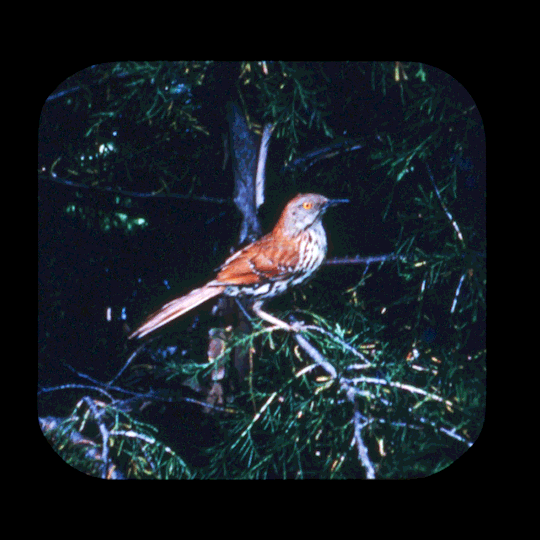
See you next time, and happy birding!
Introduction to the State Birds Initiative
1. Delaware - Poll | Results 2. Pennsylvania - Poll | Results 3. New Jersey - Poll | Results 4. Georgia - Poll | Results 5. Connecticut - Poll | Results 6. Massachusetts - Poll | Results
#birds#bird#state bird initiative#state birds initiative#birdwatching#bird watching#birding#birders#black birder#state bird#new jersey#birdblr#birblr#american goldfinch#eastern goldfinch#spinus tristis#saltmarsh sparrow#sparrow#golfdinch#ammospiza#laughing gull#gull#seagull#northern harrier#raptor#clapper rail#rail#rallus#cape may warbler#cape may
136 notes
·
View notes
Text

@glartswap for @mynonah
Smile for the camera📸💖
#besties on a vacation with the boyfriends#kurt and mercedes having the best time#and blam…. yeah#blaine with his bird thing just wanted to watch the seagulls or something#it didn’t like sam for some reason 😭#samcedes#kurtcedes#klaine#blam#glee#glartswap2024
77 notes
·
View notes
Text
BOTD: Sabine's Gull

Photo: Charles Gates
"A small gull with a spectacular wing pattern. Generally a prized sighting for birders, because it nests on tundra of the high Arctic and migrates south at sea, often well offshore. A young Sabine's that goes astray in fall may cause excitement by showing up on a pond far inland. Delicate in its feeding, this species often floats in the air low over the water, dipping down to take food from the surface without landing. Its flight action may suggest a tern more than a gull."
- Audubon Field's Guide
#birds#sabine's gull#birds of north america#north american birds#gulls#seabirds#seagulls#birds of the us#birds of canada#birds of mexico#birds of central america#birding#birdblr#birblr#bird watching#bird of the day#Xema sabini
67 notes
·
View notes
Photo

96 notes
·
View notes
Text



IG
#photograph#my photos#photooftheday#picture#photoshoot#photographer#photo#photography#photoshop#bird#birds#bird watching#bird photography#birdwatching#birbs#seagull#seagulls#bird photos#nature animals#nature photography#nature aesthetic#nature lovers#nature images#landscape#grasses#grass#grasslands#grass type#field#nature
85 notes
·
View notes
Text


whole cake island live doodle reaction
#jo catch up on one piece tag#my art#made this 3 days ago forgot to post cause wano is hypnotizing ig. my conclusion to one piece so far is i need to draw everyone hugging. the#all love each others so much. need to draw kid and killer hugging next specifically because MANNN#also if i had to pick a fav episode im thinking 957+some of 958?(im watching the kai version so idk) i just love the geopolitics of it all.#everytime i see those seagulls im so happy because it means stuff is happening and thats so cool. also the animation at morgans' office was#sooooo good. the whole ep really. like everything has consequences on the world thats one of my fav thing about one piece#undescribed
474 notes
·
View notes
Text
Seagull ST19 Movement: The Evolutionary Journey from Swiss Venus to Chinese Legend

When discussing mechanical chronograph movements, one of the most fascinating stories in horology is the transformation of the Swiss Venus 175 into what is now known as the Seagull ST19. This movement not only represents a significant milestone in Chinese watchmaking but also showcases China’s ability to refine and improve upon an already esteemed Swiss design. The journey from Venus 175 to ST19 is a testament to Seagull’s relentless pursuit of innovation and precision in the world of horology.
The Swiss Venus 175: A Foundation of Excellence

The story of the Seagull ST19 movement begins in the mid-20th century with the Venus 175, a column-wheel chronograph movement developed by the Swiss manufacturer Venus. Known for its smooth actuation and mechanical reliability, the Venus 175 was a preferred choice for many luxury timepieces during its era. However, as Swiss watchmaking technology advanced and production costs rose, Venus sought to modernize its product line by replacing the 175 with more cost-effective cam-actuated chronographs. This led to the sale of the Venus 175 tooling and blueprints to China in the early 1960s.
China’s Acquisition and the Birth of the ST19

In 1961, the Tianjin Watch Factory (which would later become Seagull) acquired the complete production machinery and intellectual property for the Venus 175. The movement was intended to be used in timepieces for military pilots in the Chinese Air Force. Seagull’s engineers meticulously studied and refined the movement, ensuring that it met the demanding requirements of precision and durability needed for aviation use. By 1963, the first batch of Chinese-made chronographs featuring the adapted Venus 175 movement was successfully produced, marking the birth of the ST19.
Key Improvements: How ST19 Evolved Beyond Venus 175

While the ST19 retains the core structure and column-wheel mechanism of the Venus 175, Seagull has implemented several advancements to enhance its performance and reliability:
Enhanced Manufacturing Precision
The ST19 benefits from modernized production techniques that allow for tighter tolerances and improved durability. With the adoption of CNC machining and updated assembly procedures, the movement operates with greater accuracy and consistency compared to its Swiss predecessor.
Higher Jewel Count
One of the refinements made by Seagull was increasing the jewel count, which helps to reduce friction and improve the movement’s longevity. This advancement has contributed to the ST19’s reputation for long-term reliability.
Expanded Production and Versatility
Unlike the Venus 175, which was used primarily in Swiss luxury chronographs of the mid-20th century, the ST19 has been adapted for a wide range of modern applications. Today, the movement powers not only aviation-inspired chronographs but also a variety of mechanical timepieces available to collectors worldwide.
Decoration and Finishing
Seagull has also refined the aesthetics of the ST19, offering variants with blued screws, Geneva stripes, and other decorative enhancements that appeal to watch enthusiasts who appreciate fine craftsmanship.
The Global Recognition of the ST19

Over the years, the Seagull ST19 has gained a dedicated following among horology enthusiasts and collectors. Its combination of Swiss heritage, Chinese innovation, and exceptional value has made it one of the most respected mechanical chronograph movements in the industry. Many independent watch brands have incorporated the ST19 into their timepieces, further cementing its place in global watchmaking.
Today, Seagull continues to refine and evolve its mechanical movements, pushing the boundaries of precision and craftsmanship. The success of the ST19 is not just a story of adaptation but one of evolution, demonstrating how China has transformed a historic Swiss movement into a modern masterpiece.
For those seeking a timepiece with a rich historical background, robust mechanical performance, and a touch of aviation heritage, a watch powered by the Seagull ST19 remains an exceptional choice.
To check out Seagull watches: https://seagullwatches.com/
#chinese watch#seagull watch#seagull 1963#seagull watches#chinese#luxury watches#tourbillon#watch collecting
0 notes
Text



Noisy
#photographers on tumblr#original photography#birding#bird photography#bird watching#seagull#Mew Gull#Sturmmöwe#Travemünde#Untertrave
743 notes
·
View notes
Text

Coexisting
#photo of the day#photography#harbor seals#seals#marine mammals#marine life#seagulls#todays bird#bird lovers#bird watching#bird photography#nature photography#wildlife photography#wild nj#nikon photography#nikon coolpix p1000#Sandy Hook Gateway National Recreation Area#Highlands NJ#nj isnt boring#winter 2025
15 notes
·
View notes
Text

Laughing Gull
#photographers on tumblr#photography#nature#landscape#florida#birds#birdblr#bird watching#birding#bird#birds of tumblr#sea birds#seagull#laughing gull
10 notes
·
View notes
Text

#Seagull#bird in flight#landscape#photographers on tumblr#original photographers#nature#britain#trees#adventure#wildlife photography#scotland#travel#travel blog#travel photography#wanderlust#vacation#road trip#Fort William#bird photography#bird watching
21 notes
·
View notes
Text
BOTD: Herring Gull

Photo: Alexis Lours
"Large, abundant, and widespread, the Herring Gull is among the most familiar members of its family, especially in the northeast. It has been extending its range toward the south along the Atlantic Coast in recent decades. In the west, where there are several similar large gulls, no such range expansion seems to be taking place."
- Audubon Field Guide
#birds#herring gull#birds of north america#north american birds#gulls#seagulls#seabirds#birds of the us#birds of canada#birds of mexico#birds of central america#birds of the caribbean#birding#bird watching#birdblr#birblr#bird of the day#Larus argentatus
87 notes
·
View notes
Text

this is where I post from
#ooc#tbd#I cannot take a photo that does this spot justice though#you can just barely see the highway across the water#its so nice to watch the cars go by from miles away#and the waves lap this little peninsula and sound so calming#there's always herons and seagulls flying around#sometimes eagles#sorry for so much ooc today writing broke my brain and Im just trying to reset before ai try to move the plot along tonight#bc i csnt do much else until then w how I set things up lol
7 notes
·
View notes